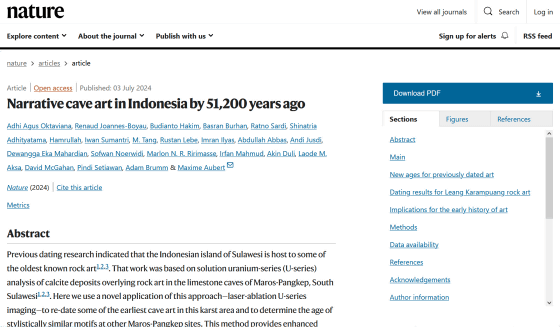The world's oldest story-telling mural, dating back 51,000 years, discovered in Indonesian cave

A new dating method has revealed that a cave painting discovered in southwestern
Narrative cave art in Indonesia by 51,200 years ago | Nature
https://www.nature.com/articles/s41586-024-07541-7

Cave painting in Indonesia is the oldest known 'picture story' - Griffith News
https://news.griffith.edu.au/2024/07/04/cave-painting-in-indonesia-is-the-oldest-known-picture-story/
Found in a cave in Indonesia, we can now show the world's oldest figurative art, which is 51,200 years old
https://theconversation.com/found-in-a-cave-in-indonesia-we-can-now-show-the-worlds-oldest-figurative-art-is-51-200-years-old-233663
51,000-year-old Indonesian cave painting may be the world's oldest storytelling art | Live Science
https://www.livescience.com/archaeology/51000-year-old-indonesian-cave-painting-may-be-the-worlds-oldest-storytelling-art
Many cave paintings dating back tens of thousands of years have been found in Sulawesi, and a 2019 study reported that a mural depicting a 'half-human, half-beast hunter' was painted about 44,000 years ago, the oldest known at the time. A subsequent 2021 study found that a mural of a warthog (Sus celebensis) , native to Sulawesi, painted in the same area was even older, dating back at least 45,500 years .
The world's oldest animal mural, painted more than 44,000 years ago, depicts a 'half-human, half-beast hunter' - GIGAZINE

Now, a research team from the Indonesian National Research and Innovation Agency and Griffith University in Australia has used a new dating method to investigate the age of the cave paintings in Sulawesi.
One method for dating cave paintings is to measure how long ago the paintings were painted by using uranium , which is contained in calcium carbonate particles formed by water droplets or flowing over layers of pigment. This method, called the 'U-series,' typically involves manually digging up samples and analyzing them all at once, but this method has the problem of homogenizing calcium carbonate layers of different ages.
The team developed an analytical technique to precisely sample different calcium carbonate layers, including those close to the cave paintings, by shining a laser on the calcium carbonate layers. Using this method, called 'laser ablation U-series imaging,' they again dated the Sulawesi cave paintings. As a result, they confirmed that the cave paintings, which were previously thought to be about 44,000 years old and depict a 'half-human, half-beast hunter,' dated to about 48,000 years ago, more than 4,000 years earlier.
In addition, a cave painting depicting three human figures interacting with a wild boar, discovered in the 'Leang Karampuang' cave, was found to be at least 51,200 years old. The team believes that this mural is the oldest known art that tells a 'story' that something is happening in the work.
You can see the 51,200-year-old cave paintings actually discovered in Sulawesi in the video below.
New discovery! 51,200-year-old cave painting in Sulawesi, Indonesia - YouTube
The world's oldest known 'narrative cave paintings' were discovered on the Indonesian island of Sulawesi.

With the naked eye, all I can see is a faint shadow of something.

It looks like this when colored. Three figures that look like people are surrounding a large boar, and it can be seen that some kind of exchange is taking place. The research team pointed out that one of the three people is holding something close to the boar's throat, and one seems to be upside down on the boar's head. The last person, drawn larger than the others, seems to be holding an unidentified object and wearing some kind of headgear.

Professor Adam Blum, an evolutionary anthropologist at Griffith University, said the discovery was important because it redefines our understanding of when humans developed the ability to tell complex stories through painting.

The research team said, 'We don't know what story the cave paintings tell. They could be records of real boar hunts, or they could depict myths or imaginary stories. In any case, they are likely to have been about the boar-human interaction that early humans in Sulawesi thought about. We know that humans have used figurative art to tell stories for at least 51,000 years. Our new dating method may help fill in the knowledge gaps about this important development in art history.'
Related Posts:






